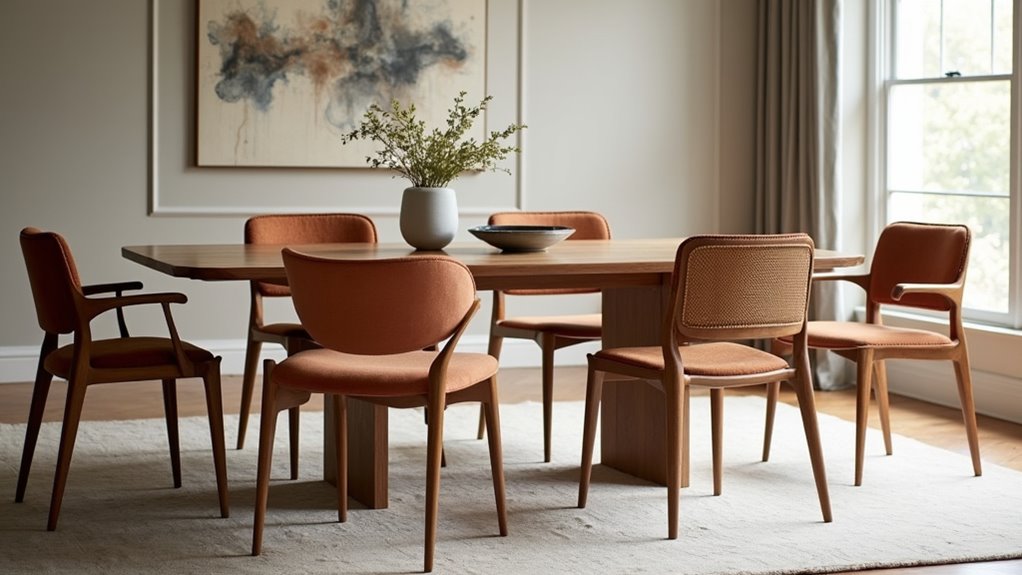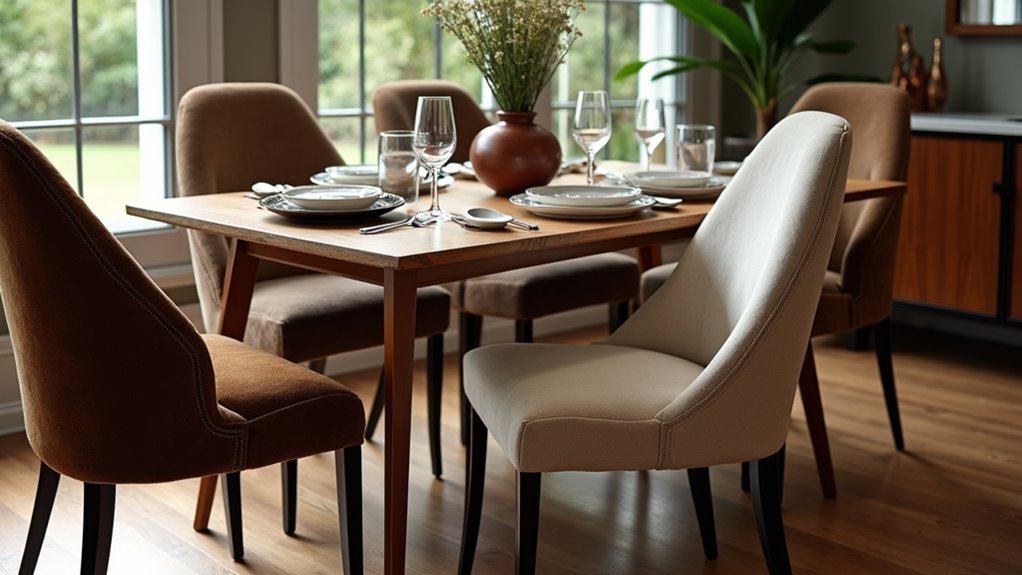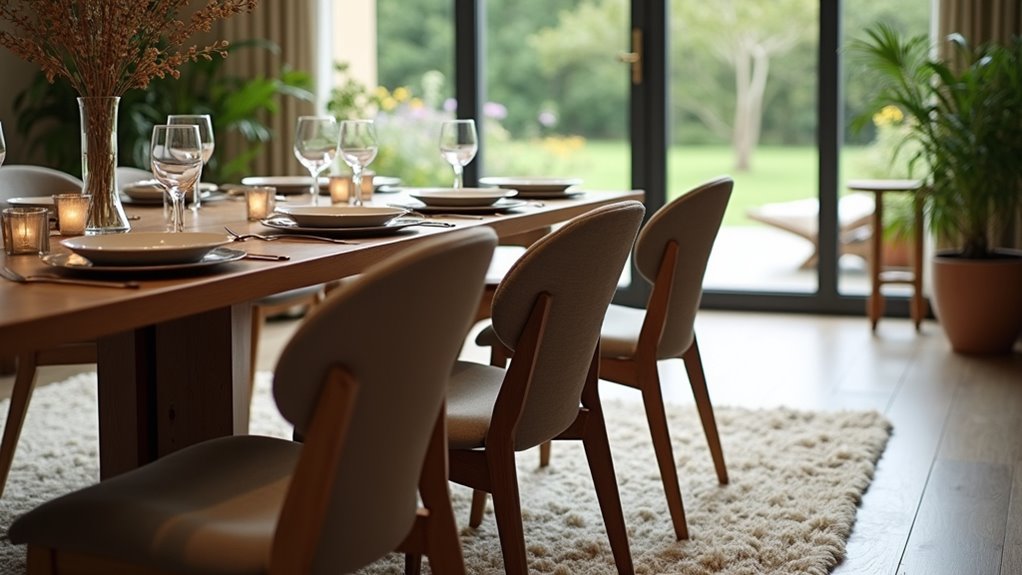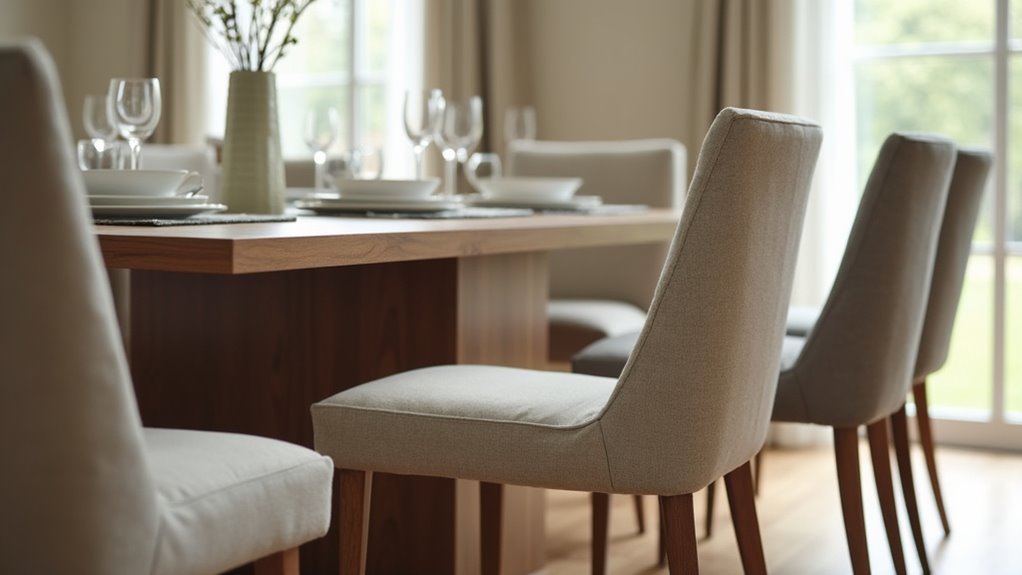Proper spacing between dining chairs and walls is crucial for comfort and functionality. Recommended clearance behind each chair is 36 inches, allowing smooth movement while dining. A minimum distance of 24-30 inches between chair backs and walls ensures an inviting atmosphere. In high-traffic areas, increasing clearance to 48 inches maximizes ease of access. Armless chairs and strategic table placement can optimize space. For more insights on achieving the perfect dining experience, further guidance awaits.
Key Takeaways
- Maintain a minimum clearance of 24-30 inches between chair backs and walls to ensure comfortable seating and easy movement.
- Aim for 36 inches of clearance behind each chair for smooth entry and exit for diners.
- Allow 8-10 inches between chairs to prevent overcrowding and promote a comfortable dining experience.
- In tight spaces, ensure at least 30 inches of movement clearance to facilitate unobstructed traffic flow.
- For high-traffic areas, strive for 36-48 inches of clearance behind seated diners to minimize disruptions.
Understanding the Importance of Clearance
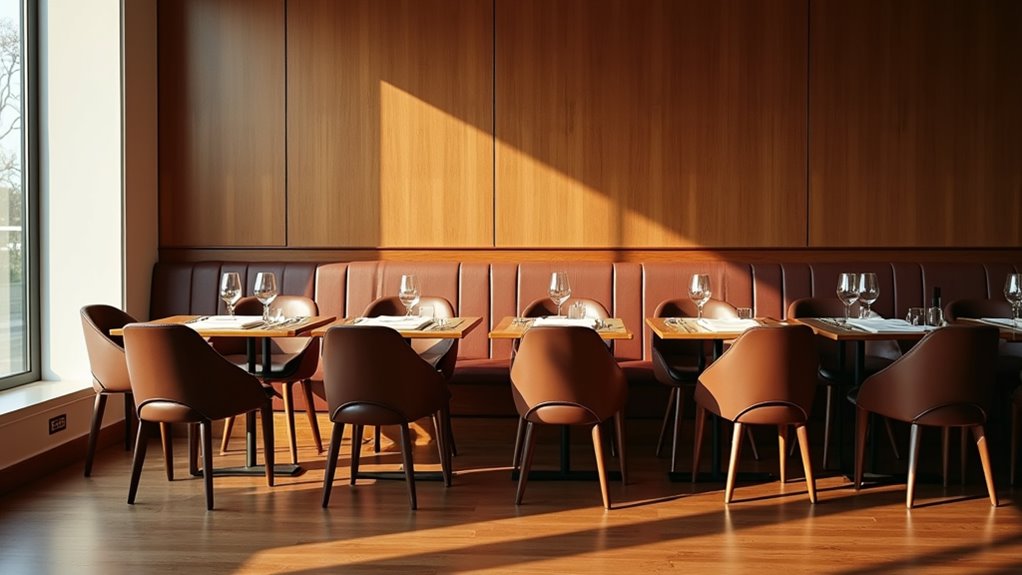
Clearance in a dining setting serves as an essential foundation for functionality and comfort. The benefits of maintaining adequate clearance are manifold, influencing the overall dining experience significantly. A well-considered functional design fosters ease of movement, allowing guests to navigate freely without feeling cramped. This open space facilitates both serving and clearing meals efficiently, ensuring that seated diners remain undisturbed. Additionally, proper clearance accommodates individuals using mobility aids, promoting accessibility for all. It also keeps pathways unobstructed, allowing for a natural flow of traffic and essential emergency egress. Seating areas should ensure an ideal seat-to-table distance, fostering a comfortable and enjoyable dining experience. Maintaining at least 36 inches between dining table and furniture helps to enhance the overall functionality of the space. Furthermore, adequate clearance also ensures that there is enough room for the efficient staff circulation to provide excellent service.
Minimum Space Requirements for Dining Chairs

In establishing the minimum space requirements for dining chairs, a careful balance must be struck between comfort and accessibility. Recommended clearances, particularly in high-traffic areas, enable seamless movement while managing limited spaces presents unique challenges that require strategic planning. Optimal backrest angle and ergonomic design also play a crucial role in ensuring a comfortable dining experience, as well-designed seating can promote healthier eating habits and prolong the enjoyment of the meal. Understanding these variables ensures an inviting and functional dining environment.
Recommended Clearances Explained
A minimum of 36 inches (91 cm) behind each dining chair is essential for ensuring comfortable movement and accessibility. This space allows diners to pull out their chairs with ease and engage fully at the table. Proper chair placement not only facilitates smooth entry and exit but also enhances the dining experience.
Additionally, maintaining a wall distance of 24-30 inches ensures that chair backs do not clash with walls, which could hinder movement. For optimal spacing, a general rule dictates 8-10 inches (20-25 cm) between chairs, providing sufficient elbow room.
Respecting these minimum space requirements cultivates an inviting atmosphere, transforming the dining area into a harmonious space where comfort and functionality coalesce seamlessly.
Managing Limited Spaces
When managing limited spaces for dining chairs, thoughtful consideration of minimum clearance is vital to balancing practicality with comfort. The absolute minimum clearance of 30 inches allows for basic movement, while 36 inches promotes more comfortable usage, ensuring a smooth flow around seated guests.
Effective furniture arrangement employs space optimization techniques; armless chairs and benches maximize seating without sacrificing comfort. Design strategies like pushing a table against a wall or using slim-profile chairs enhance visual balance, making a compact area feel larger.
Additionally, prioritizing a circulation zone of 18-36 inches preserves functionality in tight quarters. Implementing these approaches creates a harmonious dining environment, even in the coziest of spaces, while ensuring chairs can be utilized effortlessly.
High-Traffic Area Considerations
Effective management of space around dining chairs takes on increased significance in high-traffic areas, where the flow of movement often dictates the overall ambiance. Ensuring proper spacing minimizes disruptions and enhances comfort, particularly when foot traffic is a consideration in furniture arrangement.
| Requirement | Minimum Clearance |
|---|---|
| Walking Behind Seated Diners | 36-48 inches |
| Movement Around Dining Table | 24-36 inches |
| Clearance for Armchairs | 36 inches |
| Ideal Clearance in Busy Areas | 48 inches |
Adhering to these measurements not only simplifies navigation but also protects walls from wear and tear. Thus, creating a harmonious environment requires mindful planning around every chair and wall to accommodate busy pathways.
Ideal Clearance for High-Traffic Areas

Maintaining ideal clearance in high-traffic areas is essential for facilitating smooth movement around dining spaces. A minimum of 36 inches between the dining table and walls or furniture allows for optimal traffic flow, ensuring that guests can navigate without obstruction.
For pathways behind seated individuals, a clearance of at least 44 inches is recommended, providing ample room for movement. Seated guests should have 36 inches to edge past comfortably.
Additionally, a distance of 24 inches between dining chairs fosters a cohesive seating arrangement, reducing the likelihood of collisions.
A spacing of 24 inches between dining chairs enhances seating harmony and minimizes the chances of collisions.
Altogether, these measurements enhance not only the aesthetics of the space but also the overall dining experience, enabling guests to enjoy their time together without the stress of restricted mobility.
Adjusting for Limited Space Situations

Navigating limited space situations requires innovative solutions to balance comfort and functionality in dining areas.
Space-saving designs are essential; opting for round or oval tables enhances flow, while pedestal bases maximize seating and legroom.
Low-profile, airy, and armless chairs can decrease visual bulk, and backless benches provide practical seating options that tuck neatly beneath tables.
Creating a cozy nook by positioning the dining set in a corner can effectively utilize floor space.
To further enhance adaptability, extendable or drop-leaf tables offer flexibility during gatherings.
Transparent furnishings, such as glass or acrylic, create a light and open atmosphere, making small areas feel more expansive while accommodating flexible furnishings that serve multiple purposes.
The Wayfairs Sarayah 6-Person Dining Set Chairs feature a compact footprint that allows for optimal space utilization, perfect for smaller areas.
Optimal Walkway and Circulation Considerations

In the realm of dining chair arrangements, optimal walkway and circulation considerations are paramount for creating a harmonious dining experience.
A clearance of at least 36 inches from the table edge to walls or furniture not only facilitates comfortable seating but also ensures unobstructed movement for guests.
Striking the right balance between ideal clearance distances and comfortable movement zones enriches the overall aesthetic and functionality of the dining space.
Ideal Clearance Distances
Achieving ideal clearance distances around dining chairs is essential for enhancing the overall dining experience. A minimum of 36 inches (91 cm) from the table edge to the wall ensures diners can move freely, while tighter spaces may require 24-30 inches (61-76 cm). This space allows for different chair styles without the risk of scuffs or scratches, preserving dining aesthetics.
For standard walkways, maintaining 36 inches (91 cm) enables comfortable navigation behind seated diners. Ideally, 48 inches (122 cm) promotes a more spacious atmosphere, allowing for easy movement even when chairs are occupied.
Comfortable Movement Zones
Comfortable movement zones are vital for creating an engaging dining atmosphere, ensuring that guests can transition seamlessly between seated and standing positions.
Effective furniture arrangement necessitates clearly defined circulation pathways, typically requiring 18-36 inches for unobstructed movement. A recommended width of three feet behind each chair enhances fluidity, while maintaining a one-meter gap between the table edge and any wall facilitates ease of passage.
In open-concept spaces, establishing distinct zones helps organize traffic flow, minimizing congestion. Careful consideration of architectural features further optimizes pathways, ensuring that dining ambiance remains inviting.
Spacing for Individual Place Settings

A well-considered dining arrangement prioritizes personal space, ensuring each diner enjoys their meal without feeling cramped.
A thoughtful dining setup emphasizes personal space, allowing diners to savor their meals comfortably.
For optimal dining etiquette, it is recommended to allocate a minimum width of 24 inches (60-61 cm) per guest, allowing for a comfortable experience. A more generous formal setting would benefit from 30 inches (76 cm) per place setting. When space is limited, 50-60 cm can be utilized, albeit in a cozy manner.
Depth also plays a significant role; a minimum of 21 inches (53 cm) is essential, ideally extending to 27 inches (69 cm) for enhanced comfort. Consider selecting chairs with proper seat height to ensure that diners have ample legroom under the table.
A careful balance between individual preferences and necessary elbow room creates an inviting atmosphere for everyone, enhancing the overall dining experience.
Ensuring Comfortable Table and Chair Heights

Achieving the right balance between table and chair heights is essential for an enjoyable dining experience.
Standard dining tables typically reach 28 to 30 inches, while chair seats range from 17 to 20 inches, creating an optimal ergonomic alignment.
A gap of 10 to 12 inches between the chair seat and the tabletop ensures ample legroom and comfort for diners.
Ideal Table Height
The harmony of dining experiences often hinges on the ideal interplay between table and chair heights. Standard dining tables typically range from 28 to 30 inches, accommodating diverse seating options effectively. Meanwhile, alternative table heights—like counter and bar heights—offer unique atmospheres and styles.
| Table Style | Height Range |
|---|---|
| Standard Dining | 28 to 30 inches |
| Counter Height | 34 to 36 inches |
| Bar Height | 40 to 42 inches |
| Multi-Use Tables | 30 to 36 inches |
| Formal Dining Tables | 30 to 32 inches |
Proper clearance of 10 to 12 inches between the chair seat and tabletop ensures comfort. Ultimately, careful consideration of height helps avoid discomfort during meals, enhancing overall enjoyment.
Chair Seat Dimensions
Chair seat dimensions play a crucial role in ensuring a harmonious relationship between seating arrangements and table heights.
Standard dining chair seat heights typically range from 18 to 23 inches, which aligns well with 30-inch high tables, creating an ideal 10 to 12 inches of space between the chair seat and tabletop. A depth of 16 to 18 inches offers optimal thigh support, while widths from 16 to 20 inches provide varying comfort levels.
Particularly, chairs measuring 19 to 20 inches wide enhance spaciousness. The backrest height, generally 12 to 16 inches from the seat, should slightly recline for comfort.
Understanding chair size is essential for a pleasing dining experience, ensuring both comfort and aesthetic balance in any dining area.
Legroom Requirements
Proper legroom plays a significant role in enhancing the dining experience, complementing the considerations of chair seat dimensions. Achieving optimal legroom adjustments ensures diners sit comfortably, with feet planted flat and knees at a 90-degree angle.
The ideal gap between chairs and tables varies, but a distance of 10 to 12 inches is often recommended, promoting relaxed postures. Adequate clearance from table aprons and thoughtful design of table bases can elevate space optimization, allowing for a more fluid dining interaction.
Particularly, counter and bar heights require special attention, as chair height must align with table dimensions to maintain that vital space. Ultimately, these nuanced considerations culminate in a harmonious dining atmosphere.
Accommodating Different Dining Table Shapes
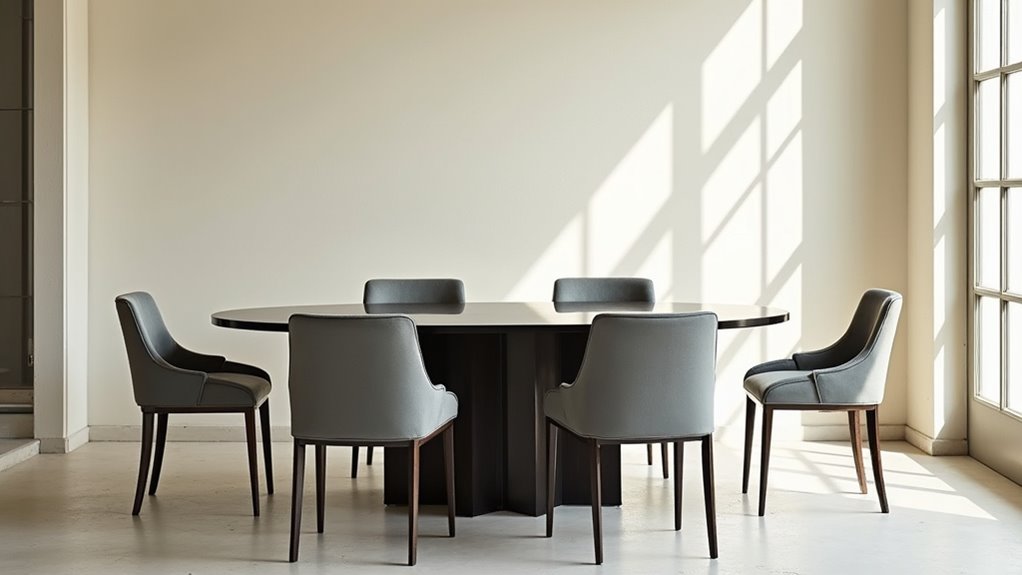
Various dining table shapes each have unique characteristics that influence their arrangement in a dining space. Understanding these shapes enhances table shape aesthetics while catering to dining style preferences.
- Rectangular Tables: Best for long, narrow rooms; they provide ample seating and promote balance.
- Round Tables: Ideal for smaller spaces, their corners-free design encourages intimacy and fluid movement, allowing for engaging conversations.
- Square Tables: Offering symmetry, they foster close interactions, perfect for smaller gatherings while maximizing space efficiency.
Each table shape requires strategic placement, ensuring a minimum clearance of 30-36 inches.
Accessibility Considerations for All Guests
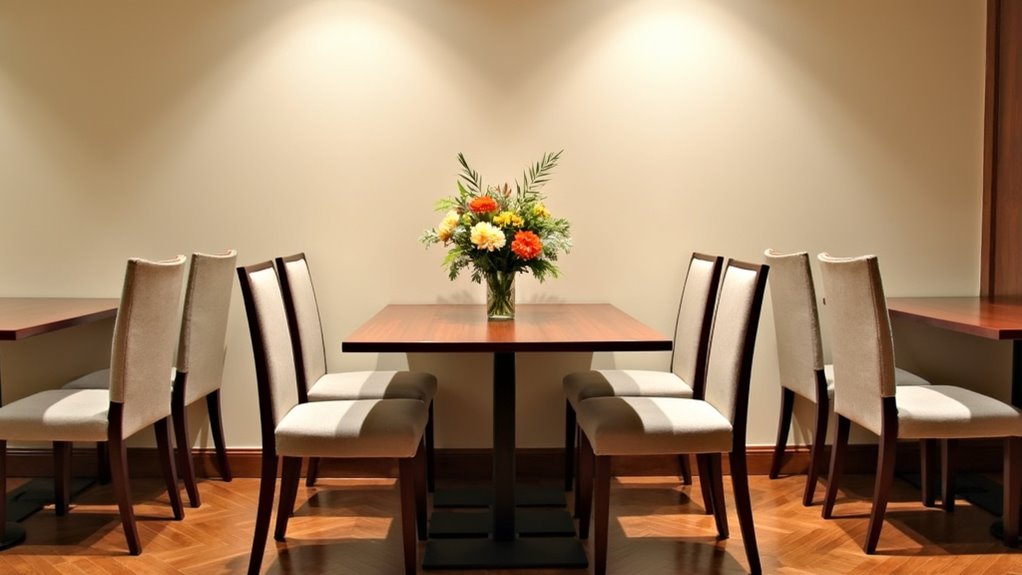
Creating a dining space that accommodates a diverse range of guests requires careful attention to accessibility considerations. Implements such as adjustable tables and sturdy chairs enhance comfort, aligning with inclusive design principles.
To ensure wheelchair users navigate effortlessly, tables should feature a minimum height of 28 inches and clear under-surface dimensions. Pathways must be at least 36 inches wide, complemented by stable chairs with appropriate armrests.
Lighting should be ample, with color contrasts easing visibility for those with low vision. Providing menus in accessible formats, while maintaining unobstructed walkways, exemplifies vital accessibility features.
Dispersing accessible seating throughout the dining area fosters a welcoming environment, allowing all guests to enjoy their dining experience fully.
Creative Solutions for Small Dining Areas

Maximizing the functionality of small dining areas can transform even the coziest spaces into inviting and efficient dining environments.
By selecting the right elements, homeowners can create a seamless dining experience, even in limited spaces.
Here are three creative solutions:
- Opt for space saving furniture: Choose round or oval tables with pedestal bases to enhance legroom and optimize space.
- Incorporate flexible seating: Use armless chairs or backless stools that tuck under the table, along with benches that offer built-in storage.
- Utilize wall space: Install wall-mounted or fold-down tables to keep floors clear when not in use, or convert an unused corner into a charming dining nook.
These strategies ensure style without compromising on functionality.


